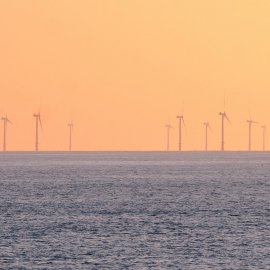Ocean Power
-
English
-
ListenPause
[intro music] Welcome to World Ocean Radio… I’m Peter Neill, Director of the World Ocean Observatory We are trapped in a maelstrom of energy questions. Do we abandon fossil fuels? How? At what pace to meet the critical challenges of climate change? What are the alternatives? How can they be implemented to scale? How quickly? And will the new energy paradigm be shared equally with the undeveloped nations that will need financial support to make the change required? At what cost? When? As early as needed? Now? These questions preoccupy the world, its leaders recently gathered in Glasgow, Scotland, to posture and negotiate, to reconcile narrow national interests with the over-arching and necessary good for the planet. The goals and objectives, the pledges for future political action and investment, the best intentions, are all to be welcomed and celebrated. But my question is: are we so focused on the near-term that we are making bad decisions for the long term, a time that will be perhaps upon us before the noble resolve at COP26 can reach effect? The success of alternative fuels is proven: wind and solar generation at small scale and large rapidly overtaking the extent of fossil fuels. The energy companies, still not invested in what they continue to see as competition, not progressive technology, continue to make the “transition” argument: that we continue to need fossil fuels to feed the ongoing expansion of transportation and manufacturing to sustain the conventional economy. The major banks are revealed, despite so-called Environmental/Social/Governmental (ESG) criteria, to remain invested in the traditional energy construct, including coal. Only the problem of methane release was fully recognized at COP, and we’ll see about the implementation to follow. As another example, consider the rush to electric vehicles and other devices reliant on batteries, a technology itself reliant on certain rare metals for the storage capacity and operating chips required to make it work. But there is already a problem of supply of these necessary resources; they are concentrated in certain places: China, Greenland, the deep ocean floor, even down the road from me where an extraordinary deposit was just discovered on a local farm. But, to deliver that supply we must rely on the old technology again: open pit, watershed polluting, mining; destruction of the ocean floor; toxic dust and emissions; destroyed biodiversity; exported profits; displaced communities; casuistry and greenwashing, inequitable distribution of value at a true ESG cost not included in the value equation. There is more than the simple, uncertain question of adequate supply to meet a new insatiable demand. Is it possible that we will be building millions of charging stations for vehicles that cannot be produced due to unrealized availability of the elements that make them work? It is the tyranny of governance that governors must always be trapped in the present. But there are ideas and technologies, old and new, that must be addressed and developed as prescient escape. It may be that we missing the biggest opportunities by thinking too small. Examples: Massive public investment in solar production and the reconstruction of an efficient national distribution grid. Wind power, offshore, at a scale already productive in Europe. Intensified research in nuclear power, safety, alternative technologies, fusion. And then there is the ocean itself. Wave and tidal energy, for example. I have long advocated for the potential of ocean geothermal energy. The ocean is the world’s largest heat pump, using temperature differential to generate heat to drive turbines to generate electricity, possibly located in abandoned coastal oil-fired plants, making power to drive integrated desalination and aquaculture to meet other, local, immediate social needs. And here’s another one: salinity gradient power—where major rivers meet the sea, where huge volumes of freshwater meet equal volumes of salt water, mixing and reaching equilibrium, releasing energy that can be captured by either osmosis or by reverse electrodialysis. These are not new ideas. Trials and demonstration projects were conducted in the 1970’s when projections suggested that salinity gradient power based on average ocean salinity and global river discharge could meet the entire global electrical demand. But they failed for lack of capital investment, political incentive, adherence to the fossil fuel model at a time when climate change and its concomitant threats of global warming, ocean acidification, sea level rise, extreme weather, and now evident social/political consequence was a theory or a projection dismissed by the fully invested status quo. Is there time? For the ocean to save the land? We will discuss these issues, and more, in future editions of World Ocean Radio. [outro music]
This week on World Ocean Radio we're discussing energy present and energy future, and the ways that alternative energy technologies are changing the landscape as our energy needs grow. We offer examples of proven alternative fuels such as wind, solar, wave and tidal energy and share some lesser-known technologies such as salinity gradient power and geo-thermal energy that could use the power of the ocean to meet global electrical demand.
About World Ocean Radio
Peter Neill, Director of the World Ocean Observatory and host of World Ocean Radio, provides coverage of a broad spectrum of ocean issues from science and education to advocacy and exemplary projects. World Ocean Radio, a project of the World Ocean Observatory, is a weekly series of five-minute audio essays available for syndicated use at no cost by college and community radio stations worldwide.
World Ocean Radio is produced in association with WERU-FM in Blue Hill, Maine and is distributed by the Public Radio Exchange and the Pacifica Network.
Available for podcast download wherever you listen to your favorites.
Image
Theodor Vasile @theodorrr on Unsplash
- Login to post comments



